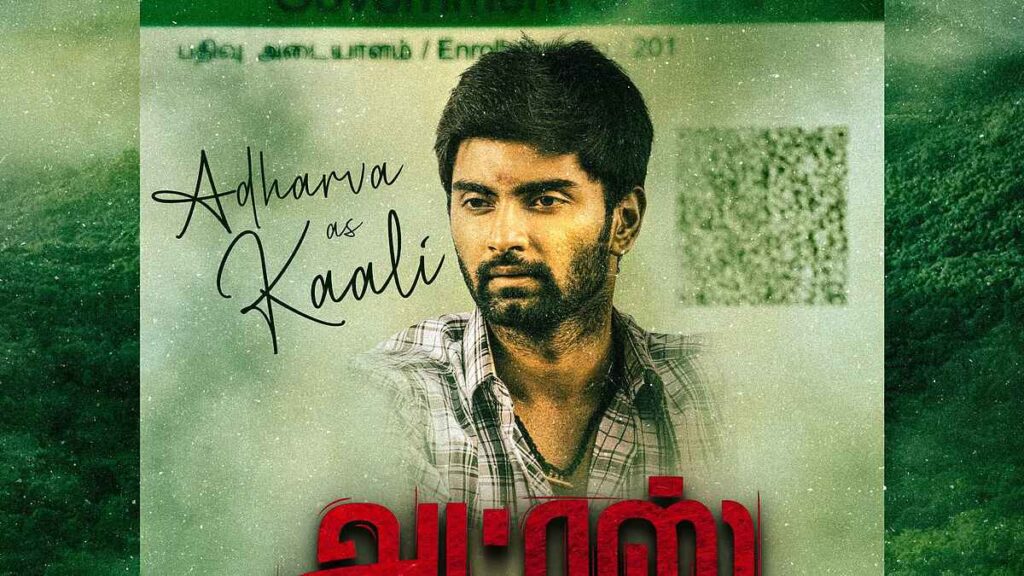Address is a Tamil-language action drama directed and written by Rajamohan, and produced by Ajey Krishna under Cocktail Cinemas and SS Media. The protagonist is Esakki Barath, with Atharvaa making a lengthy cameo appearance. Pooja Jhaveri, Dhiya, Thambi Ramaiah, Devadarshini, A. Venkatesh, Poster Nandakumar, Nagendran, and Goli Soda Muthu play supporting roles.
Girishh Gopalakrishnan composed the music, Krishnakumar Venkatasamy and Srinivas Dayanidhi did the cinematography, and Tamil Arasan edited it. Set against the backdrop of the 1956 reorganisation of states, the film portrays the instability endured by a village on the Tamil Nadu-Kerala border due to language division borderlines.
Goli Soda, Muthu. Girishh Gopalakrishnan composed the soundtrack, while Krishnakumar Venkatasamy and Srinivas Dayanidhi directed the cinematography and edited it. Set against the backdrop of the 1956 reorganisation of states, the film portrays the instability experienced by a village on the Tamil Nadu-Kerala border due to language division borderlines.
The Plot And Themes
The narrative centers on Esakki Barath’s character-a man whose village suddenly finds itself stateless, grappling with issues like disrupted identity, lack of administrative recognition (literally no address), and ensuing strife. We move with him through the maze of officialdom, rising tensions, and fights for dignity and belonging.
Themes include: Identity and Belonging: How do they claim their homeland when the lines on a map move overnight? Bureaucratic alienation: The friction between grassroots life and changing political contexts. Collective resilience is the power of When institutions collapse, the community comes together. Nostalgia and Loss: There’s a subtle undercurrent of remembering and regaining a lost past. These themes echo deeply in today’s setting of identity politics and geolinguistic pride, giving the historical drama weight beyond its day.
The Characters
Esakki Barath gives a powerful, grounded performance. He exhibits calm dignity in the face of institutional neglect while also eliciting emotional empathy in rural landscapes. His portrayal combines the modesty of a rural lad with the determination of a man facing an existential crisis. Atharvaa, despite his limited appearance, delivers a powerful performance. His character Kaali represents a turning point in the tale and injects much-needed charm and emotional anchorpoint as the drama scales.
The supporting cast, which includes Pooja Jhaveri, Dhiya, Thambi Ramaiah, and others, provides adequate texture. Thambi Ramaiah adds his signature subtle humour, as well as a terrifying roughness when things become violent. Devadarshini skilfully contributes to the plot by demonstrating maternal power. The group seems entrenched, even if certain individuals aren’t well developed.

Cinematography and Direction
Rajamohan’s scriptwriting excels in smoothly combining history, action, and politics. His stories have a beautiful flow. He spends time with the characters before drastically raising the stakes—but never cheaply—for dramatic effect. Pacing is generally superb. The first hour is heavy on mid-century detail, but the second hour steadily tightens into protest, conflict, and optimism.
Krishnakumar Venkatasamy and Srinivas Dayanidhi’s nag-rich rural frames showcase ordinary lives—faces, cottages, nature—with absorbing genuineness. Meanwhile, dramatic conflict sequences are deliberately designed to elicit suspense while maintaining clarity. It’s visually accurate to the 1950s rural South. Tamil Arasan’s editing punctuates when the plot requires clarity and pauses when it requires reflection. A few sequences, particularly in the last act, are lengthier than necessary, but the narrative flow stays tight.
The Strength
- Conceptual Courage: Tackle the human cost of the 1956 reorganization is unusual in mainstream Tamil film.
- Lead Performance: Esakki Barath grounds the film with quiet strength.
- Immersive Environment: From clothes to cinematography, the era feels real.
- Narrative Integrity: No superfluous. Subplots exist; each scene contributes to the resolution of the central conflict.
- Musical Resonance: The Score helps without obscuring emotional depth.
The Weakness
- Pacing Lulls: A few lagging conversation sections in the middle of the act might be cut.
- Character Depth: Some supporting characters, particularly those in female positions, might have been developed deeper.
- Limited Scope: The picture remains village-centric. While this is primarily a strength, the larger political background or counter-narratives (such as views from Kerala and Tamil Nadu officials) are only briefly discussed.
- Promotional Gaps: With little pre-release hype, audience awareness and box-office reach might be limited.
Also Read…..
Ryan Gosling’s ‘Project Hail Mary’ Is a Sci-Fi Masterpiece; Plot Explained
Conclusion: Who Should Watch It?
Address emerges as a quietly captivating drama that prioritises realism, human struggle, and the often-overlooked intersection between small-scale history and daily life. Its themes of belonging, recognition, and perseverance reverberate well beyond 1956, connecting with contemporary issues about boundaries, identity, and representation. Fans of historical and rural plays. Viewers who value content above commercial spectacle those interested in the postcolonial Indian identity and political history.
Fans of grounded, performative storytelling. Overall, a smart, well-acted, and technically sound picture that solidifies Rajamohan’s development as a filmmaker who tackles complex storylines.
If you enjoy stories set in genuine sociopolitical situations and driven by human resiliency rather than manufactured beauty, Address is a must-see. It talks about big Tamil releases in 2025, even if the first audience pull isn’t blockbuster-level.
Written by Nilesh Shiv
